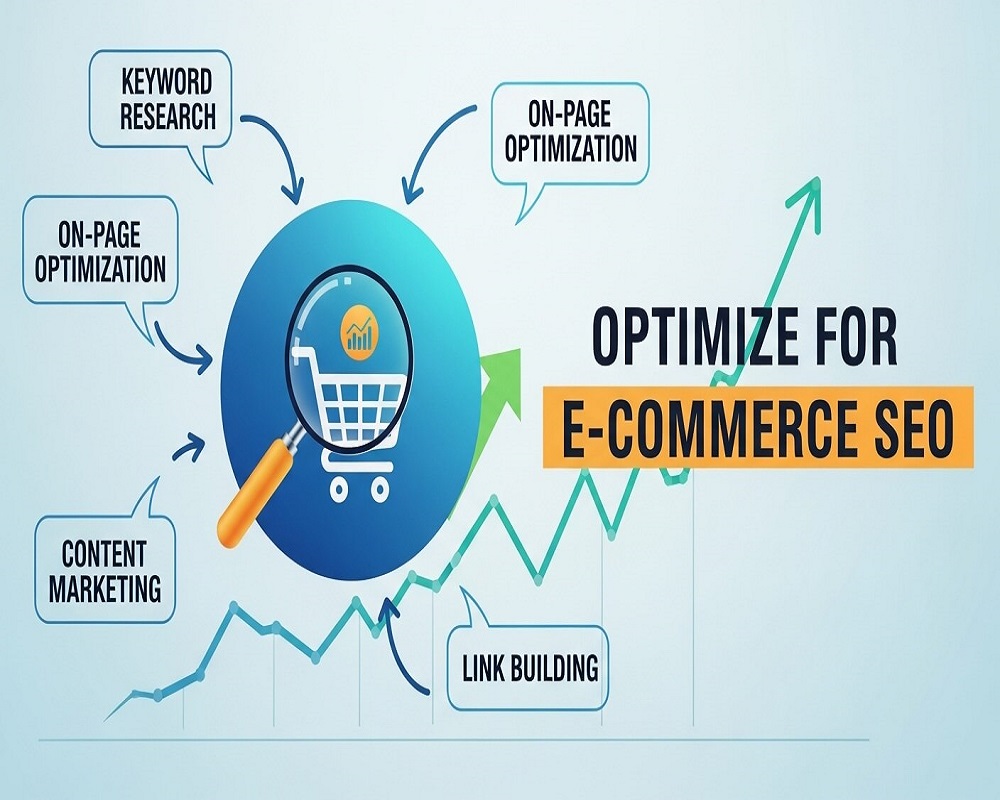In the competitive digital marketplace of 2025, mastering how to optimize for ecommerce seo is critical for online retailers aiming to boost organic traffic, increase conversions, and outshine competitors. With search engines like Google prioritizing user intent, mobile experiences, and high-quality content, e-commerce businesses must leverage advanced strategies to secure top rankings and capture valuable search queries. This comprehensive, 3,000-word guide provides actionable insights, industry data, and real-world examples to refine your approach. Whether you run a niche online store or a large-scale retail platform, these techniques will enhance visibility, drive engagement, and maximize sales through targeted ecommerce seo strategies.
The Evolution of E-Commerce SEO in 2025
E-commerce SEO has evolved significantly, driven by AI-powered algorithms, voice search, and changing consumer behaviors. The global e-commerce market is valued at over $8 trillion in 2025, with organic search accounting for over half of website traffic to online stores. Unlike general SEO, ecommerce seo focuses on transactional and commercial intent, targeting queries like “buy wireless earbuds online” or “best laptop under $1000” that signal immediate purchase intent.
The primary goal is to align your site with user needs while meeting search engine standards. Google’s algorithms now reward sites that demonstrate deep expertise, authority, and trustworthiness, emphasizing the importance of credible content. Organic search offers a strong return on investment, often outperforming paid ads by delivering consistent traffic at lower costs. Key challenges include managing dynamic product inventories, avoiding duplicate content from variants, and integrating with platforms like Shopify or WooCommerce. In 2025, personalized search results powered by AI analytics are standard, with optimized stores seeing significantly higher conversion rates.
Keyword Research: The Foundation of E-Commerce SEO
Keyword research is the cornerstone of ecommerce seo, pinpointing terms that attract qualified buyers. Start by understanding search intent: informational (“how to choose a coffee maker”), navigational (“Nespresso website”), commercial (“best coffee makers 2025”), and transactional (“buy Nespresso machine”). Focus on commercial and transactional keywords, which convert at higher rates due to their purchase-driven nature.
Use tools like Google Keyword Planner, Ahrefs, or Semrush to identify high-volume, low-competition keywords. For example, a broad term like “wireless earbuds” may have massive search volume, but long-tail variants like “best wireless earbuds under $50” offer lower competition and stronger buyer intent. Group keywords into thematic clusters, such as a “running shoes” cluster including “best men’s running shoes,” “women’s trail runners,” and “affordable sneakers.” This approach builds topical authority, signaling to Google that your site is a comprehensive resource for the niche.
Competitor analysis helps uncover keyword gaps. Analyze rivals’ top pages to identify terms you can target. Tools like AnswerThePublic reveal question-based queries, such as “how to pick running shoes,” which are ideal for FAQs and featured snippets. Long-tail keywords dominate searches, driving higher conversions due to their specificity.
On-Page Optimization: Crafting Product Pages That Convert
On-page SEO turns clicks into sales. Create unique product titles, such as “Men’s Nike Air Zoom Pegasus 42 Running Shoes – Blue, Size 10,” incorporating primary keywords within 60 characters to ensure full display in search results. Product descriptions should be 200–500 words, detailing features, benefits, and keywords without duplicating content across similar products. For example, emphasize “cushioned soles for marathon training” for one shoe and “lightweight design for casual runs” for another. Use structured data markup for Products, Offers, and Reviews to enable rich snippets, which can significantly boost click-through rates.
Optimize images with descriptive alt text, like “blue Nike running shoes side view,” and compress files under 100KB for faster loading. High-quality visuals, such as 360-degree views or product videos, enhance engagement and reduce bounce rates. URLs should be clean and keyword-rich, such as /mens-running-shoes/nike-air-zoom-pegasus. Breadcrumbs improve navigation and distribute internal link equity.
Category pages act as content hubs. Include unique introductions, filters for size or color, and related product suggestions. Encourage user reviews through post-purchase emails, as most consumers rely on reviews to inform buying decisions, enhancing trust and rankings.
Technical SEO: Building a Robust E-Commerce Foundation
Technical SEO ensures your site is crawlable, fast, and user-friendly. Adopt a flat site architecture with categories no more than three clicks from the homepage. Submit XML sitemaps via Google Search Console to guide crawlers to priority pages. Mobile optimization is essential, as mobile devices drive a significant portion of e-commerce traffic. Use responsive design and test with Google’s Mobile-Friendly Test. Meet Core Web Vitals benchmarks: Largest Contentful Paint under 2.5 seconds, First Input Delay under 100 milliseconds, and Cumulative Layout Shift below 0.1.
Address duplicate content with canonical tags for product variants (e.g., different colors) and use robots.txt to block non-essential pages like shopping carts. Implement rel=next/prev tags for paginated pages to consolidate authority. Site speed is critical—over half of users abandon sites that load slower than 3 seconds. Optimize with image compression, code minification, and browser caching, using tools like GTmetrix to identify bottlenecks.
Secure your site with HTTPS via SSL certificates to build user trust and improve rankings. For international stores, use hreflang tags to target specific languages and regions, ensuring content reaches the right audience.
Content Marketing: Driving Traffic Beyond Product Pages
Content marketing amplifies ecommerce seo by attracting early-stage buyers and building authority. Blogs targeting informational keywords, such as “how to choose running shoes,” draw top-funnel traffic that converts through internal links to product pages. Aim for 1,500–2,500-word posts with visuals, lists, or tables to target featured snippets. For instance, a “Guide to Home Workouts” linking to fitness gear can drive significant sales increases.
Incorporate user-generated content like reviews and testimonials on product pages to boost trust. Video content, such as tutorials on YouTube or TikTok, drives referral traffic and backlinks, with a high percentage of marketers reporting strong returns from video SEO. Guest posting on niche-relevant sites builds authority and links. Email newsletters nurture leads, encouraging repeat visits that signal positive engagement to search engines.
Off-Page SEO: Building Authority and Backlinks
Off-page SEO strengthens your site’s reputation through external signals. High-quality backlinks from authoritative domains are critical. Use strategies like broken link building, responding to journalist queries, or collaborating with influencers to earn dofollow links. Focus on relevance—links from industry-related sites carry more weight.
Submit your store to directories like Google Business Profile and niche-specific platforms for local SEO benefits. Share content on social media platforms like Instagram or Pinterest to drive referral traffic and indirect backlinks. Earn media mentions through PR campaigns to enhance brand credibility. Monitor backlinks with tools like Ahrefs and disavow low-quality links to avoid penalties. Quality links from trusted sources outperform numerous low-value ones.
Mobile and Voice Search Optimization for E-Commerce
With mobile devices dominating e-commerce traffic, optimize for touch-friendly navigation and fast load times. Accelerated Mobile Pages (AMP) for product pages improve mobile rendering, boosting rankings. Test mobile usability regularly to meet Google’s mobile-first indexing standards.
Voice search is growing, with many households using smart speakers. Target conversational, long-tail keywords like “best affordable wireless earbuds near me.” Structured data enables voice assistants to pull direct answers, increasing visibility in voice results. Progressive Web Apps (PWAs) offer app-like experiences on the web, reducing bounce rates and improving engagement.
AI and Emerging Trends in E-Commerce SEO
AI is reshaping ecommerce seo in 2025. Tools like content optimization platforms generate keyword-rich drafts aligned with top-ranking pages. Predictive analytics forecast trending products, guiding SEO strategies for inventory pages. Visual search, powered by tools like Google Lens, requires optimized images with descriptive filenames and alt text to capture searches.
Zero-click searches, where answers appear in featured snippets, account for a significant portion of clicks. Structure content with clear headings, lists, and tables to win these spots. Sustainability is also trending—keywords like “eco-friendly clothing” resonate with consumers, as many prioritize green brands.
Essential Tools for E-Commerce SEO in 2025
Leverage these tools to streamline your efforts:
- Ahrefs: For backlink analysis and keyword research ($99/month).
- Semrush: Comprehensive site audits and competitor insights ($129/month).
- Google Search Console: Free monitoring of indexing and performance.
- Screaming Frog: Crawl audits for technical issues ($259/year).
- Yoast SEO: On-page optimization for WordPress sites.
- Surfer SEO: Content optimization based on SERP analysis ($59/month).
These tools, enhanced by AI integrations, help identify opportunities and track performance efficiently.
Measuring and Iterating E-Commerce SEO Success
Track key performance indicators like organic traffic, conversion rate (2–5% benchmark), and keyword rankings using Google Analytics 4, Google Search Console, and Ahrefs. Calculate ROI: (Revenue from organic traffic – SEO costs) ÷ SEO costs. Conduct A/B tests on product pages to optimize click-through rates and conversions.
Perform quarterly audits to address technical issues and refresh content. Data-driven adjustments are critical, with many successful e-commerce sites attributing growth to consistent optimization.
Case Studies: Real-World E-Commerce SEO Success
A fashion retailer optimized product pages with unique descriptions and structured data, boosting organic traffic by 45% in six months. An electronics store implemented content clusters around “best gadgets” keywords, increasing conversions by 25% through targeted blog-to-product linking. These examples demonstrate the power of strategic ecommerce seo in driving measurable results.
Frequently Asked Questions (FAQs)
1.How do I optimize product pages for e-commerce SEO?
Craft unique titles and descriptions with keywords, add schema markup, optimize images with alt text, and encourage user reviews for trust and rankings.
2.What are the top e-commerce SEO tools in 2025?
Ahrefs, Semrush, Google Search Console, Screaming Frog, Yoast SEO, and Surfer SEO streamline keyword research, audits, and content optimization.
3.How can I perform keyword research for e-commerce SEO?
Use Ahrefs or Semrush to target high-volume, low-competition commercial and transactional keywords, clustering them for topical authority.
4.What is the ROI potential of e-commerce SEO?
Organic search drives over half of e-commerce traffic, offering high ROI compared to paid ads, with consistent traffic and conversions.
5.Why is site speed critical for e-commerce SEO?
Fast load times (under 3 seconds) reduce bounce rates and improve rankings, as over half of users abandon slower sites.
6.How does mobile optimization impact e-commerce SEO?
Mobile drives significant traffic; responsive design and fast load times align with Google’s mobile-first indexing, boosting rankings.
7.How can I manage duplicate content in e-commerce?
Use canonical tags for product variants, 301 redirects for outdated pages, and unique descriptions to avoid penalties.
8.What role does content marketing play in e-commerce SEO?
Blogs and guides attract early-stage buyers, build authority, and drive conversions through internal links to product pages.
9.How do I build backlinks for my e-commerce site?
Earn links through guest posts, influencer partnerships, and PR campaigns, focusing on high-authority, niche-relevant domains.
10.What are key e-commerce SEO trends for 2025?
AI-driven personalization, voice and visual search optimization, and sustainability keywords align with consumer and algorithmic shifts.
11.How can voice search optimization benefit e-commerce?
Target conversational long-tail keywords and use structured data to appear in voice assistant answers, capturing local buyers.
12.Why are user reviews important for e-commerce SEO?
Reviews provide fresh content, build trust, and increase click-through rates, with most consumers relying on them before purchasing.
13.How does schema markup improve e-commerce SEO?
Product, Offer, and Review schemas enable rich snippets, enhancing visibility and click-through rates in search results.
14.What common e-commerce SEO mistakes should I avoid?
Avoid duplicate content, neglecting mobile optimization, poor site structure, and skipping regular technical audits.
15.How do I measure success in e-commerce SEO?
Track organic traffic, conversion rates, keyword rankings, and ROI using Google Analytics, Search Console, and Ahrefs.
Conclusion
Mastering how to optimize for ecommerce seo in 2025 requires a strategic blend of keyword research, on-page and technical optimization, content marketing, and off-page authority building. By prioritizing user intent, mobile performance, and high-quality content, e-commerce sites can achieve higher rankings, increased traffic, and better conversions. The strategies outlined—leveraging long-tail keywords, optimizing product pages, ensuring technical excellence, and embracing emerging trends like AI and voice search—equip retailers to thrive in a competitive landscape. Start with a site audit using tools like Google Search Console or Ahrefs, implement these advanced tactics, and monitor progress to drive sustained growth. With organic search as a cornerstone of e-commerce success, investing in ecommerce seo today positions your store for long-term profitability and market dominance.
Saad Raza is an SEO specialist with 7+ years of experience in driving organic growth and improving search rankings. Skilled in data-driven strategies, keyword research, content optimization, and technical SEO, he helps businesses boost online visibility and achieve sustainable results. Passionate about staying ahead of industry trends, Saad delivers measurable success for his clients.





